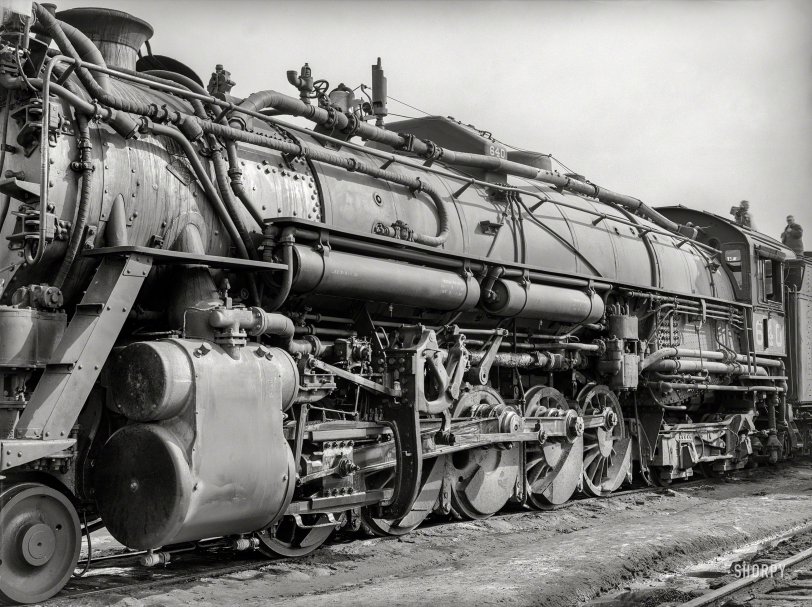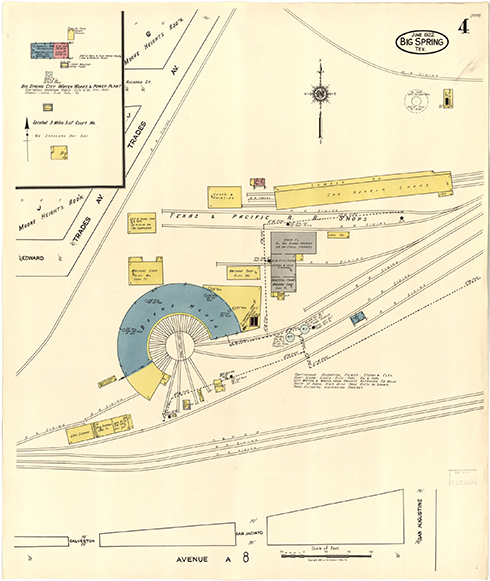


Framed or unframed, desk size to sofa size, printed by us in Arizona and Alabama since 2007. Explore now.
Shorpy is funded by you. Patreon contributors get an ad-free experience.
Learn more.

- Illuminate us
- I remember it well
- I can't prove it
- Complicated then, forgotten now
- Bryan-Stevenson
- Skinny is as skinny does
- How do you rest in peace
- Riding the footboards
- Alas, hidden from view
- Baldwin Diesels
- Exclusive pump
- Bananas, Oysters and Smokey Joe
- Details, Details
- What's that building to the left of the tower?
- Coal Barges
- Bromo-Seltzer
- Inner harbor
- The Basin
- What a headache!
- Giant stepladder?
- Yeah, it was cold
- Love those coats
- Link & Pin Days Remnant
- Baldwin 62303
- Baldwin VO-1000
- Cold
- No expense spared
- Tough Guys
- What's your hurry, where's your hat?
- Sheriff's Signature
Print Emporium
The Locomotion: 1940

March 1940. "Detail of locomotive while in the yard at Big Spring, Texas." Medium format negative by Russell Lee for the FSA. View full size.
Big Spring Yards
Found this Sanborn Map of the yards and roundhouse for the T&P. Wonder which track this guy was parked on.

For the May Day is the great day
The two small tanks above the drivers announce that they were last serviced on "5-1-39". I'm not sure what LS, HT, and LSO meant, but they were important to keep track of. There were probably paper records at the locomotive's headquarters or rebuild shop, but nothing beats having it written right there on the part - especially if you're at an outlying roundhouse, trying to decide if it needs service or not. Even back then, there were some federal regulations on how often things like the boilers and the brakes had to be inspected and maintained - "Clean, Oil, Test, and Stencil" was a required procedure for some air brake components.
Even though the records are computerized now, the railroads still like to put dates and other information right on the equipment. The next time you're first in line at a railroad crossing, you might see markings like "NEW 06-18" or "BLT 06-18" on a brand-new freight car, or a date when an older car was repainted. They also tend to have details on what kinds of paints were used, what kinds of brake shoes the car needs, and a few other things. On newer cars, all of this stuff will be on vinyl stickers, instead of hand-painted, but it will be there. This site gives a few details of what the markings would have looked like, from the 1960s at least up through the 1980s.
Sometimes, if a freight car has graffiti covering up the stencil, the railroad will put a fresh sticker or stencil over the graffiti. Once in a blue moon, you see one where the graffiti writer knew to keep clear of the stencils, but that is rare.
A very small remnant
#640's older sister, #610 (built 1927) is the only surviving example of the Texas class. In 1976 she underwent a 1472 inspection and restoration to bring her into service to pull the Bicentennial Freedom Train through parts of Texas. After a stint as an excursion-train front end on the Southern in the 1980s, she was donated to the Texas State Railroad in 1987 and has been on static display in Palestine, Texas ever since.
Sister loco #638 was scrapped in the 1970s due to extensive vandalism.
Railroad Rash
It looks like the locomotive has parking lot scrapes on it. How does that happen to something on tracks?
Nifty design
I would have been afraid that the first set of wheels would come off, but that locomotive appears to have been working for at least 15 years. Somebody did some good engineering with that.
Lima Locomotive
This is a Texas & Pacific 2-10-4 type, built for freight and an early example of a Lima Locomotive Works "Super Power" locomotive. The T&P 2-10-4s were the first of that wheel arrangement, and those that followed on other railroads were referred to as Texas types. I posted another photo of a T&P Texas on here a while back, a full locomotive portrait: https://www.shorpy.com/node/4501
























On Shorpy:
Today’s Top 5